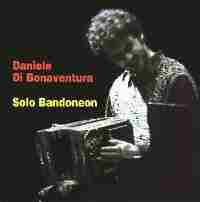The Free-Reed Review
Critiques of Compact Discs, Books and Music Scores
CD Review: Daniele Di Bonaventura
Solo Bandoneon

total time: 27:58
released: 1998
review date: February 1999
label: CD No. DdB 002
(Privately produced by the artist)
contact: Daniele Di Bonaventura
Via Battisti, 21
63023 Fermo (AP)
Italy
telephone: 0039 0734 225256
e-mail: ddibon@tin.it
website: http://www.ejn.it/mus/dibonaventura.htm
|
Daniele Di Bonaventura, bandoneon
Program:
- Los Sueños – Piazzolla
- Regresso al Amor – Piazzolla
- Bruno y Sarah – Piazzolla
- Ballata Triste – Di Bonaventura
- Reminiscenze (Inno) – Di Bonaventura
- La Caccia – Di Bonaventura
- Tristezza Speracion – Piazzolla
- Prelude to the Cyclical Night – Piazzolla
|
Gregory A.
Vozar:
Only after several decades of relative obscurity has the bandoneon been
able to stand center-stage and take a belated and well-deserved curtain
call. Once familiar to central Europeans as a "folk" instrument and to the
people of Argentina and Uruguay as an essential part of an orquesta
típica or tango ensemble, its voice has been heard only occasionally
outside these regions. However, during the present decade, a growing
circle of musicians seems drawn to this German concertina. No doubt this
resurgence of awareness began with the music of Argentinean composer and
bandoneonist, Astor Piazzolla, but the instrument's expressive potential
has already carried it beyond this into the realm of jazz and experimental
music.
After this brief exposure to his playing, it is apparent that Daniele di
Bonaventura is one of the new musicians for whom the bandoneon is more
than a passing fancy. A native of Fermo, Italy, he began his musical
studies at the age of eight, first concentrating on the piano and
composition and later, taking up the bandoneon. Making this difficult
transition was worth the effort, for he seems to have found the perfect
vehicle for self-expression.
On his album, Solo Bandoneon, Di Bonaventura has chosen simply and
chosen well, exploring a rich yet seldom played Piazzolla repertoire. He
offers us five short and introspective pieces that share the multiple
attributes of tango, classical music and jazz. These mildly rhapsodic
"tangos" are reminiscent of the unmeasured preludes of late 17th century
French keyboard repertoire. Their melodies unroll freely, supported only
by a chordal accompaniment and unfettered by formal rhythm. This gives the
performer considerable opportunity to embellish, accent and shape the
melodic line. Di Bonaventura does this securely and well, creating a
strong sense of alternating tension and release as he allows the harmonic
architecture of each piece to dictate its form. His parlando and
impressionistic style of playing is very personal, and it suits
Piazzolla's music well. The emotional content of his performance is high,
and his ability to communicate surpasses that of other players who may be
technically superior.
The natural volume level of the bandoneon is only slightly louder than an
acoustic guitar, and it communicates well in an intimate setting. Di
Bonaventura capitalizes upon this and its other idiosyncrasies in order to
express his musical ideas. Just as a singer must take a breath between
phrases, the bandoneon must also regularly exhale or inhale. The
performer's phrasing, set parenthetically between these respirations,
gives his playing a very vocal quality and a sense of linear movement.
Midway through the disk are three of Di Bonaventura's own compositions;
these are perhaps the most poetic and attractive portion of this short
recording. Grey and drizzling skies preside over "Ballata Triste," the
first of the trio and an introspective study in a jazz ballad style. We do
not have to wait long in the damp and cold, however, for the soft glow of
cherished affection warms the wistful strains of "Remniscenze (Inno)." "La
Caccia" is a hide and seek tale, at times coquettish and playful,
occasionally mysterious and seductive, the pulse of passion never far
below its surface. Deceptively simple, these pieces are not tango
nuevo but engaging original compositions in an easy, jazz style.
Besides being good music, they are very much idiomatic to the bandoneon
and represent a new direction for its voice!
The sound quality of this compact disk is extremely good, easily making it
one of the best solo bandoneon disks I have heard. There is a near perfect
balance of "presence" and room ambiance or "space." Very sensitive
microphones have captured every color and nuance of the performance,
including the warm resonance of the instrument's wooden case, the leather
slap of valves and bellows, the click of keys and sighing exhalations of
air. Some might object to these as "noise," but I am grateful that the
engineers have retained these transient sounds, integral to the
instrument, for they add to this intimate and complex musical
experience. Also subliminally audible are the player's involuntary and
mildly ecstatic groans, the legacy of a deeply felt and passionate
performance.
I have only two minor regrets about this fine album; the first is its
length, the second is the lack of biographical details on the insert.
Given the quality of both the sound and performance, it ends far too soon!
I personally would have liked to hear a few more of Di Bonaventura's own
compositions, for it is here that he makes a unique artistic contribution
and widens the available repertoire of the bandoneon. Perhaps this is by
design. Maybe he wants to leave his listeners just a little bit hungry in
order to assure their return. If so, he has succeeded. My appetite has
only been sharpened rather than satiated by what I have heard!
